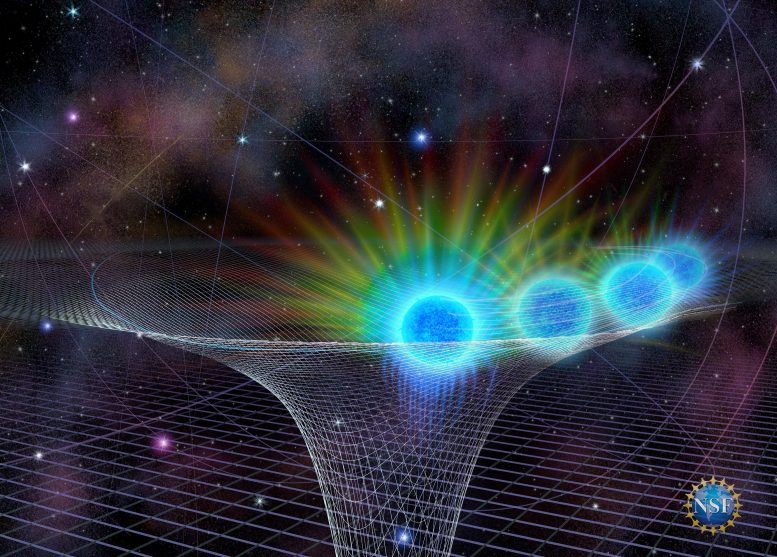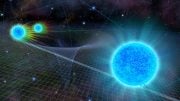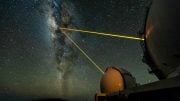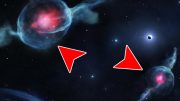
Rendering of a star called S0-2 orbiting the supermassive black hole at the center of the Milky Way. It did not fall in, but its close approach could be one reason for the black hole’s growing appetite. Credit: Artist’s rendering by Nicolle Fuller/National Science Foundation
UCLA astronomers notice brightest light in 24 years of observations.
The enormous black hole at the center of our galaxy is having an unusually large meal of interstellar gas and dust, and researchers don’t yet understand why.
“We have never seen anything like this in the 24 years we have studied the supermassive black hole,” said Andrea Ghez, UCLA professor of physics and astronomy and a co-senior author of the research. “It’s usually a pretty quiet, wimpy black hole on a diet. We don’t know what is driving this big feast.”
A paper about the study, led by the UCLA Galactic Center Group, which Ghez heads, is published today in Astrophysical Journal Letters.
The researchers analyzed more than 13,000 observations of the black hole from 133 nights since 2003. The images were gathered by the W.M. Keck Observatory in Hawaii and the European Southern Observatory’s Very Large Telescope in Chile. The team found that on May 13, the area just outside the black hole’s “point of no return” (so called because once matter enters, it can never escape) was twice as bright as the next-brightest observation.
They also observed large changes on two other nights this year; all three of those changes were “unprecedented,” Ghez said.
The brightness the scientists observed is caused by radiation from gas and dust falling into the black hole; the findings prompted them to ask whether this was an extraordinary singular event or a precursor to significantly increased activity.
“The big question is whether the black hole is entering a new phase — for example, if the spigot has been turned up and the rate of gas falling down the black hole ‘drain’ has increased for an extended period — or whether we have just seen the fireworks from a few unusual blobs of gas falling in,” said Mark Morris, UCLA professor of physics and astronomy and the paper’s co-senior author.
The team has continued to observe the area and will try to settle that question based on what they see from new images.
“We want to know how black holes grow and affect the evolution of galaxies and the universe,” said Ghez, UCLA’s Lauren B. Leichtman and Arthur E. Levine Professor of Astrophysics. “We want to know why the supermassive hole gets brighter and how it gets brighter.”
The new findings are based on observations of the black hole — which is called Sagittarius A*, or Sgr A* — during four nights in April and May at the Keck Observatory. The brightness surrounding the black hole always varies somewhat, but the scientists were stunned by the extreme variations in brightness during that timeframe, including their observations on May 13.
“The first image I saw that night, the black hole was so bright I initially mistook it for the star S0-2, because I had never seen Sagittarius A* that bright,” said UCLA research scientist Tuan Do, the study’s lead author. “But it quickly became clear the source had to be the black hole, which was really exciting.”
One hypothesis about the increased activity is that when a star called S0-2 made its closest approach to the black hole during summer of 2018, it launched a large quantity of gas that reached the black hole this year.
Another possibility involves a bizarre object known as G2, which is most likely a pair of binary stars, which made its closest approach to the black hole in 2014. It’s possible the black hole could have stripped off the outer layer of G2, Ghez said, which could help explain the increased brightness just outside the black hole.
Morris said another possibility is that the brightening corresponds to the demise of large asteroids that have been drawn into the black hole.
No danger to Earth
The black hole is some 26,000 light-years away and poses no danger to our planet. The radiation would have to be 10 billion times as bright as what the astronomers detected to affect life on Earth.
Astrophysical Journal Letters also published a second article by the researchers, describing speckle holography, the technique that enabled them to extract and use very faint information from 24 years of data they recorded from near the black hole.
Ghez’s research team reported on July 25 in the journal Science the most comprehensive test of Einstein’s iconic general theory of relativity near the black hole. Their conclusion that Einstein’s theory passed the test and is correct, at least for now, was based on their study of S0-2 as it made a complete orbit around the black hole.
Ghez’s team studies more than 3,000 stars that orbit the supermassive black hole. Since 2004, the scientists have used a powerful technology that Ghez helped pioneer, called adaptive optics, which corrects the distorting effects of the Earth’s atmosphere in real-time. But speckle holography enabled the researchers to improve the data from the decade before adaptive optics came into play. Reanalyzing data from those years helped the team conclude that they had not seen that level of brightness near the black hole in 24 years.
“It was like doing LASIK surgery on our early images,” Ghez said. “We collected the data to answer one question and serendipitously unveiled other exciting scientific discoveries that we didn’t anticipate.”
Co-authors include Gunther Witzel, a former UCLA research scientist currently at Germany’s Max Planck Institute for Radio Astronomy; Mark Morris, UCLA professor of physics and astronomy; Eric Becklin, UCLA professor emeritus of physics and astronomy; Rainer Schoedel, a researcher at Spain’s Instituto de Astrofısica de Andalucıa; and UCLA graduate students Zhuo Chen and Abhimat Gautam.
The research is funded by the National Science Foundation, W.M. Keck Foundation, the Gordon and Betty Moore Foundation, the Heising-Simons Foundation, Lauren Leichtman and Arthur Levine, and Howard and Astrid Preston.
Reference: “Unprecedented Near-infrared Brightness and Variability of Sgr A*” by Tuan Do, Gunther Witzel, Abhimat K. Gautam, Zhuo Chen, Andrea M. Ghez, Mark R. Morris, Eric E. Becklin, Anna Ciurlo, Matthew Hosek Jr., Gregory D. Martinez, Keith Matthews, Shoko Saka1, and Rainer Schödel, 11 September 2019, Astrophysical Journal Letters.
DOI: 10.3847/2041-8213/ab38c3









In my opinion, black holes do not swallow, consume, or even pull in positive density mass beyond their event horizon boundary. So how do black holes manage to exhibit a field of gravitational acceleration so strong that no mass particles, or even electromagnetic radiation such as light, can escape from it?
The answer is better understood by thinking about gravity a bit differently. In fact, one actually has to reimagine the universe from its perspective make up. Considering the current notion the standard model of cosmology, the current measurements decompose the total energy of the observable universe with 68% dark energy, 27% mass–energy via dark matter, and 5% mass-energy via ordinary matter. In which case, as black holes are significantly more energy dense than ordinary matter, it would then make more sense that black holes are a product of dark matter rather than condensed ordinary matter. This requires that we rethink these internal relationships for total energy.
Considering the ‘Big Bang’ theory from a singular point as modeled after a gravitational singularity, rather try thinking of the ‘Big Bang’ theory from a pre-existing fabric of space-time without any real matter, as a the proposed one dimensional determinant. Then start unfolding this dimensional perspective so space-time fabric into existence; first into a two dimensional space-time fabric, which is an expansion from our one dimensional space-time, and then into a three dimensional space-time fabric and so on. The expectation is that ordinary matter creation took place within a pre-existing medium of space-time. Indeed, the existence of ordinary matter would only warp the pre-existing fabric of space-time. Take away the positive density matter and you would still have a vessel in which the matter once existed. I would only be logical for the vessel to be one of dark energy; dark energy unaffected by this promulgation of matter.
Wherein the creation of ordinary matter, or positive density matter, induces a complementary displacement, or warping, in the dark energy medium of the space-time fabric. And yet this complementary displacement insulates the newly created positive density matter in an envelopment of negative density matter. This envelope of negative density matter, known as dark matter, then infiltrates the spaces in matter, providing it with the ability to interact, bond, and evolve. Indeed it would require much more dark matter to fill the spaces among ordinary matter down to its smallest constituent parts.
So if dark matter is what engenders a force of gravity for ordinary matter to bond, then the accretion and accumulation of ordinary matter is just the resultant consequence of this force. And if the black holes are nothing but dark matter, then it would also follow that dark matter can be accumulated, separate of ordinary matter. It would therefore also follow that the gravitational force is more representative of negative density mass than positive density mass.
Upon this hypothesis then, one can expect that there is a require transition to separate ordinary matter from its complementary dark matter. It starts first with the disintegration of matter, as a whole, as it interacts with the event horizon of the black hole. As the positive density mass is ‘squeezed’ upon its own gravitational acceleration toward the black hole, liken to the spaghettification effect, its matter changes to allow for its disintegration via transmutation and the massive release of photons due to alpha decay and beta decay. This is the effect wherein positive density mass is collected within the event horizon, into a plasma, increasing its photon density. This ‘squeezing’ effect is like extracting out the dark matter from the whole matter, allowing for the ordinary matter to be reduced to its smallest constituent components. The dark matter is then absorbed into the black hole, and the remnants of ordinary matter are discarded and radiated out at high velocity back into the cosmos; to start, once again, to reintegrated into the universe via bonding and evolving.
If you’re interested in exploring this concept more, please review the alternative theories presented in the book, ‘The Evolutioning of Creation: Volume 2’, or even the ramifications of these concepts in the sci-fi fantasy adventure, ‘Shadow-Forge Revelations’. The theoretical presentation brings forth a variety of alternative perspectives on the aspects of existence that form our reality.
Bringing dark matter into the equation adds a new theoretical perspective interesting to consider. The question is how did dark matter begin and what is it?